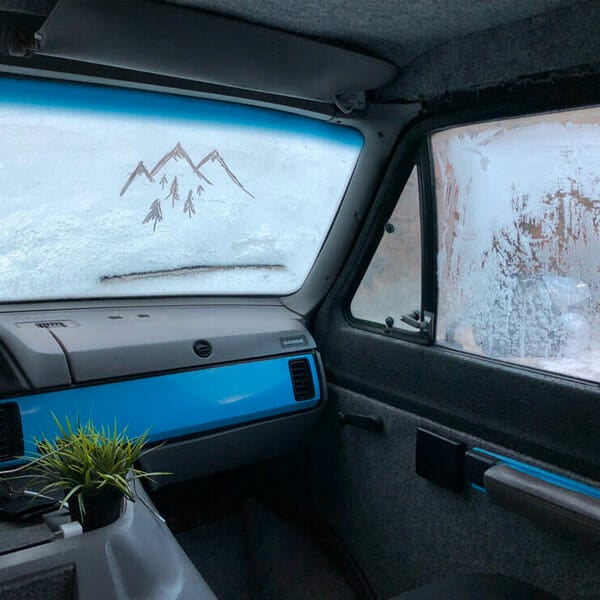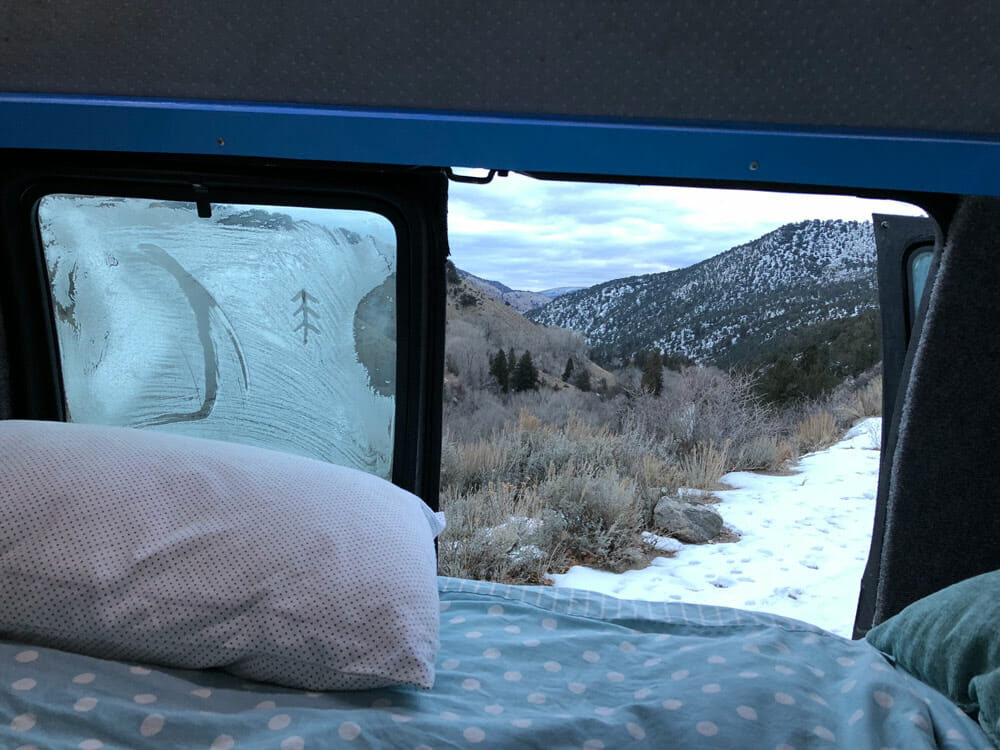Avoiding Condensation And Moisture Buildup In Your Van
When cold weather starts to roll around, condensation quickly becomes a major headache for vandwellers. Whether you’re spending the night in a van, RV or camper the pitfalls of condensation are the same. Moisture buildup can cause dampness, mold and even rust leading to an uncomfortable experience. How do you get rid of all of this water vapor? Keep reading for tips on prevention and evaporation techniques!
Condensation, Humidity, and Dew Point
Condensation occurs when vapor within the air transforms into liquid. When an object is cooler than the dew point temperature, condensation builds up on the surface.
Relative humidity levels fluctuate frequently because warm air can hold more water vapor than cold air. Cooking, running a heater, and even breathing will release water vapor, increasing relative humidity.
Dew point is the measure of actual moisture in the air. When the dew point reaches 100%, water can no longer evaporate and liquid forms.

Where Condensation Forms
Naturally, all air contains water molecules. In addition, your body is constantly releasing water vapor. The heat from your skin and breath gives off moisture into the air. Running a heater, cooking or moving around will off gas huge amounts of vapor. In an enclosed space like a van, this builds up fast!
Add these activities to the increasing temperature of your living space, and the air will quickly become warmer and more humid. When there is a large temperature difference between the cold outdoors, and a warm humid van interior, condensation will form on the cold surfaces.
The most noticeable condensation will appear on your windows, it can also form on your roof or walls if not properly sealed. When lots of condensation occurs, droplets can stick together and create wet spots that quickly lead to mold or rust if not treated.
How to Prevent Condensation
The best and most effective way to reduce condensation is through proper ventilation. It is necessary to have a constant airflow throughout the van bringing cooler, drier air in and pushing humid air out. This is especially true when adding an excess amount of moisture to the air during activities such as cooking or running a heater.
Cracking open some windows might not sound like a very comfortable idea in the winter; but secondary solutions such as dehumidifiers and moisture absorbers will simply not be successful. A van is a very tiny space and humidity needs somewhere to go.
Adding Airflow To Your Van
Having two ventilation openings in your vehicle should be the goal. Ideally, these would be placed far apart from each other so the air gets a chance to circulate throughout the van. Adding a vent fan to the ceiling that can run for an extended period of time along with a cracked window is a great solution to mitigating moisture.
Opening a window by itself will do a pretty good job of ridding your van of some condensation, but without the circulating airflow you can’t be confident that you are getting rid of the humidity before it has the chance to condense.
Installing a 12V vent fan in your ceiling is not nearly as difficult as it sounds. The most daunting part of the process is going to involve cutting a large hole in the roof. Proper airflow can be a godsend during the hot summer days and equally enjoyable throughout the winter.
As an alternative, purchasing a small battery operated or DC powered fan to place in an open window will also have a positive effect on mitigating condensation. This will require you to remember to set it up each night before bed or during high levels of activity, but is still a good solution.
Want to learn more about vent fans? Check out our article on best roof vent fans for vanlife

Fight Condensation With Dry-Heat
This will certainly not work for everyone, but depending on your goals you may choose to install a wood stove to heat your van in the cold weather. Wood stoves are highly cost effective and suck moisture out of the air. In fact, wood stoves are SO effective you may even need to add some moisture back into the air by leaving out a cup or two of water.
Externally Ventilated Air Heaters
If you have the budget, externally ventilated heaters are perhaps the best way to stay warm in the winter. The three most popular models are the Propex propane heater, and the Espar and Webasto diesel heaters.
These heaters use fuel from large tanks to keep the van warm then pump both humidity and combustable gasses out the air exhaust.
Air heaters have the huge advantage of producing significantly less water vapor than other heating options. And because they are vented to the outside, you can keep your windows closed! This leads to an all-around more comfortable experience.
Read our post on the best externally ventilated propane and diesel heaters to avoid condensation
Adding A Vapor Barrier
Vapor barriers can be a little confusing. They are very effective at preventing condensation when installed correctly. However, it is nearly impossible to do this in the context of a van so ventilation will still be required.
Although it sounds counter-intuitive, a vapor barrier should be placed on the warm side of your insulation. This is because an effective vapor barrier will prevent the humid air inside your van from reaching the cold material (metal) of your van walls and building condensation. If a vapor barrier is placed directly up against the van wall, moisture can still form in the insulation of your walls unless they are completely sealed.
A vapor barrier can be the best way to prevent condensation, but installing it correctly can be a major challenge. Luckily, Polyiso, XPS, yellow spray foam and Thinsulate insulation all act as vapor barriers. These materials do not absorb water. However, if they are not attached edge-to-edge with other moisture resistant materials, condensation can move behind them to the metal and form rust or mold. This is often worse than no barrier at all because the mold is in a stagnant environment and can grow faster. If you want to read more about insulation materials check out our post on DIY van insulation.
Not many vandwellers create a proper vapor barrier because it is difficult to attend to all of the edges, curves, corners, and holes in a van. It is also something that isn’t as easy to get right on your first build. In a perfect world, it is the best solution for a durable and healthy environment. Something simple like a box truck with one door would be the most feasible to seal off. If you have time to learn and plan a vapor barrier it is an option to look into.
Dehumidifiers and Absorbent Solutions
When fighting condensation for the first time, a dehumidifier or quick-fix moisture absorber might be the first thing that comes to mind. Unfortunately, neither of these are going to work very well in a van setting. Dehumidifiers require a constant source of electricity which is a precious resource for someone living on the road. Any dehumidifier capable of pulling enough moisture out of the air in a van will also have to be quite large and this is not very with an off-grid electrical system.
Moisture absorbers carry some of the same consequences. In order to soak up the amount of condensation a human can produce in a van (not to mention a heater), one would need a very large supply of absorbers. These methods have been tried by countless vandwellers with little success.
Dangers of Condensation
You do not want to let condensation build up in your van. This is a problem best solved during the construction stage of your van building journey. Excess moisture can quickly turn into mold and become dangerous to your health. Exposure to mold can cause skin, eye, and throat irritation. Even a small amount of untreated moisture can create rust, leading to corrosion. This is a vicious cycle that’s easier to prevent than to repair.
Maintaining proper airflow is the best way to avoid condensation. You will be living in a much more comfortable environment with constant air-exchange. Be sure to seal up all walls and ceilings correctly. When all else fails, open the windows!

So why, does a vehicles windshield frost on the inside when both front windows are open 1-2″ and there is zero moisture inside? I can leave my van that I’m currently converting and in the past other vehicles parked for multiple days in cold weather. After a few days like this the inside of the windows have frost on them even though no moisture as been added to the inside. They are closed up and not used or opened to any change of weather. I live in the PNW if that makes a difference.
Condensation occurs when vapor within the air transforms into liquid. When an object is cooler than the dew point temperature, condensation builds up on the surface. If that surface is below 32°F then it will frost. So if you have your windows open you are therefore letting in more humidity, which is always higher when it’s colder, and that humidity turns into the frost on the inside of your cold windows.
Did you read the article because it mentions all this at the very beginning.
Because condensation and moisture that is naturally in the air will collect along sharp temperature gradients. So when you talk of leaving your vans outside for a few days, they’ll heat up and cool down more slowly than the outside temperature. So in the morning when the temperature rises, the air in the van remains colder, even with the windows cracked, thus condensation forms when the warmer and colder air meet, ie your windshield etc.
I have an electric heater in my van because I’m at a campground in the Pacific Northwest and condensation is building up real bad on the cold metal walls. I’m going to insulate it when the weather warms up. Someone said you need weeping holes at the bottom of the insulation so moisture can escape. I’m wondering if you should drill small holes at the bottom of the metal of the van (sides), to let the moisture out? I’ll probably use polyiso.